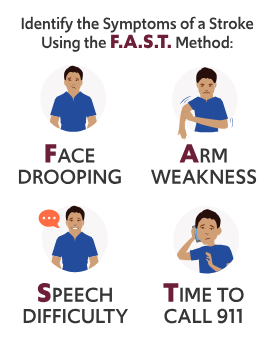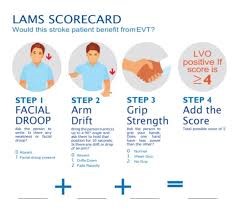
January Tip of the Month - Stroke/CVA
January Tip of the Month - Stroke/CVA
Cerebrovascular accident (CVA) is the third leading cause of death in Canada and the tenth largest contributor to disability-adjusted life years. Commonly known as strokes, they occur when blood flow to the brain is interrupted, leading to loss of brain function. There are two main types of stroke: ischemic, caused by blockage in a blood vessel, and hemorrhagic, caused by bleeding in the brain.
Symptoms of a CVA can include weakness or loss of sensation (often on one side of the body), confusion or difficulty steaking, vision difficulties, headache or loss of coordination and balance. The onset of these symptoms is typically sudden and often persist, therefore impacting quality of life.


Early recognition and transport to the hospital is paramount. Paramedics can utilize the F.A.S.T Method, and the Los Angeles motor scale to quickly assess patients for symptoms of a CVA/stroke. Any patient who meets all of the following criteria could be eligible for both intravenous thrombolysis and/or interventional treatment with EVT, therefore a stroke pre-alert should be initiated.
Patients Must:
- Present with a new onset of at least one of the following symptoms suggestive of the onset of an acute stroke:
- Unilateral arm/leg weakness or drift.
- Slurred speech or inappropriate words or mute.
- Unilateral facial droop.
- Can be transported to arrive at a Designated Stroke Centre within 6 hours of a clearly determined time of symptom onset or the time the patient was last seen in a usual state of health.
- Perform a secondary screen for a Large Vessel Occlusion (LVO) stroke using the Los Angeles Motor Scale (LAMS) and inform the CACC/ACS to aid in the determination of the most appropriate destination.
Contraindications under the Acute Stroke Protocol:
- CTAS Level 1 and/or uncorrected airway, breathing or circulatory problem.
- Symptoms of the stroke resolved prior to paramedic arrival or assessment**.
- Blood sugar <3 mmol/L.
- Seizure at onset of symptoms or observed by paramedics.
- Glasgow Coma Scale <10.
- Terminally ill or palliative care patient.
- Duration of out-of-hospital transport will exceed two hours
Once a CVA/stroke has been identified, prehospital management includes monitoring the airway, breathing, circulation, and any associated interventions. Monitor vital signs, and blood glucose levels and establish IV access. Any neurological changes including GCS should be monitored closely and relayed to receiving staff.
Understanding the signs, symptoms and risk factors of CVA/Stroke is crucial for timely intervention and recovery. With rapid assessment and communication to receiving facilities, paramedics can significantly impact the outcome and quality of life for those affected.
Please see Dr. Jon Smith's educational presentation for further details.
January Tip of the Month Video - Stroke/CVA
Stay warm, stay safe, and continue delivering excellent care!
Previous Tips
-
Winter Emergencies: Recognition and Care for Hypothermia and Frostbite
-
November Tip of the Month - Not "Just" the Flu: Recognizing High-Risk Respiratory Illness
-
October Tip of the Month - Diabetic Emergencies
-
September Tip of the Month - Sepsis
-
August Tip of the Month - Mass Casualty Incidents
-
July Tip of the Month - Breaking down Burns
-
June tip of the month - High-Quality CPR & Defibrillation
-
May Tip of the Month - Prehospital Trauma Management
-
April Tip of The Month - Paramedic resilience strategies; recognizing and managing burnout
-
March 2025 Tip of The Month - Identifying Intimate Partner Violence (IPV) in Prehospital Care